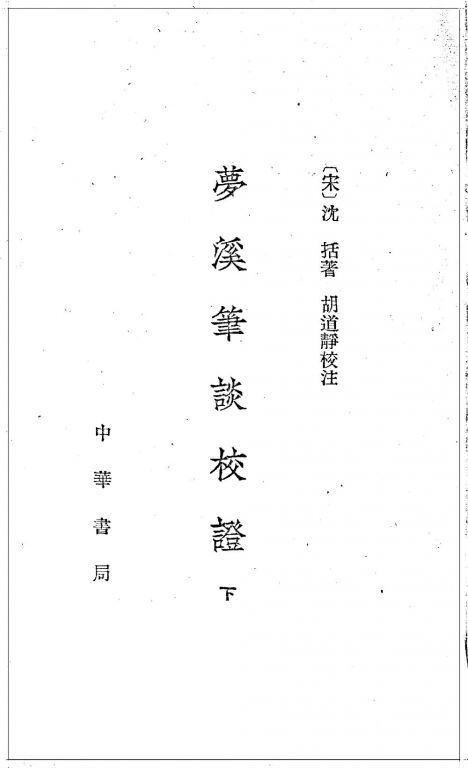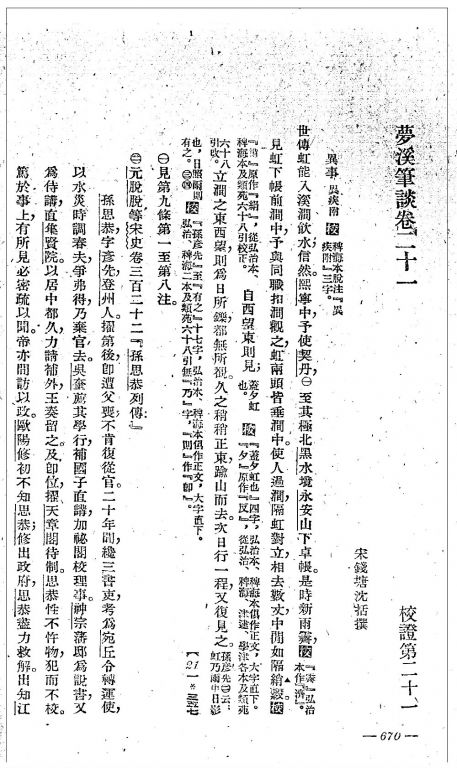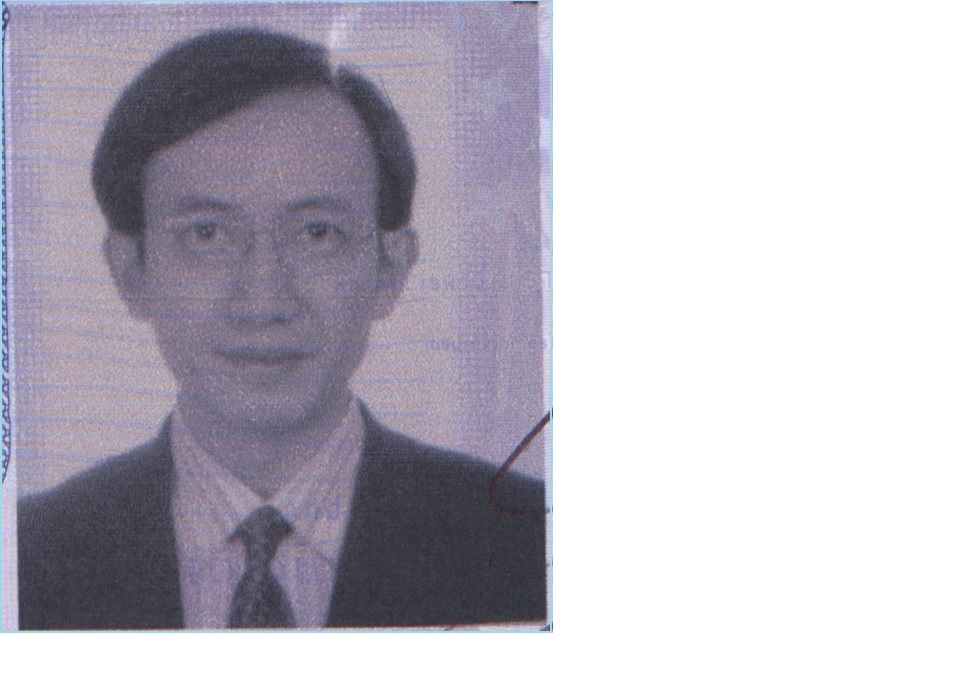博文
Window of Chinese Paleobotany-中国古植物学之窗
|||
Window of Chinese Paleobotany《中国古植物学之窗》 (150)

English introduction: Paleobotany is believed to serve as a unique window to make panoramamic perspectives on the historical and cultural processes of China’s basic science research.
It is as early as in 1086 that Shen Kuo (1029–1093), who is one of the great Chinese ancient scientists from the Song Dynasty, recorded the occurrence of fossil plants of so-called bamboo shoots in his voluminous works, Dream Pool Essays(Meng Xi Bi Tan). The fossil locality is situated at Yan-shui-guan, 35 km southeast of Yen–chuan, Shaanxi Province, where it is very dry and cool at present. The fossil plants which Shen Kuo considered to be bamboo shoots are actually assigned to the Neoclamites fossils. This fossil record is believed to be over 400 years earlier than that of Leonardo da Vinci (1452–1519) (Deng,1976; Li & Wang, 1999; Li, 2000). According to the ecological requirements and environment of bamboo shoots, Shen Kuo inferred that the climate in this fossil locality was warm and humid during the geological past providing an example of the geological principle that the present might be a key to the past. Shen Kuo’s clever idea is about 700 years earlier than that of James Hutton (1726–1797) and Charles Lyell (1797–1875) (Sun & Yang, 2000).
However,we might speculate, why such a brilliant Chinese civilization did not produce a scientific tradition. In fact, Chinese science and technology began to lag behind the occidental world from about the time of the Industrial Revolution.In the second half of the 19th century, the Chinese government of the Qing Dynasty was forced to initiate a series of open policies to foreign countries.Since the early 1870s lots of Chinese students were sent abroad to learn modern science and technology and most of them were eager to return to China to modernize the developing country after they finished their studies abroad. Although the 20th century saw a series of dramatic changes in recent Chinese history, modern science and technology was transplanted into China bit by bit. The fact is that the development of modern science and technology in China during the 20th century had a very difficult passage distorted both by international trends and by all sorts of domestic factors.
如果你想了解近现代中国基础科学发展的历史与文化过程,中国的古植物学不仅是一个很好的学科“标本”,也是一个理想的学术窗口。古植物学一直是很小众的研究领域,可是,“麻雀虽小,五脏惧全。”我们用专业眼光对这个“标本”进行了全方位的观察和解剖,获得大量信息,整合成《中国古植物学之窗》。
通过古植物学窗口我们不仅可以了解中国古植物学的兴起和发展过程及其世界联系,而且可以探讨影响中国基础科学发展的诸多问题,如:社会保障、教育制度、科研体制、学术共同体等。在北京建立“中国国家自然历史博物馆”(National Museum of Natural History of China)是几代古生物学家的梦想,它将在国家层面成为中国古植物学的稳固平台。然而,由于复杂体制和部门利益等障碍,“中国国家自然历史博物馆”至今尚未建立起来。这是硬件方面的一个典型例子。
软件方面有这样一个情形:中国古植物学的学术共同体是一个非常小众的科研文化圈,但极不寻常。两个“国字号”的专业社团--中国古生物学会古植物学分会和中国植物学会古植物学分会并存30年之久,彼此难以合作。为什么中国科学界会长期存在这种奇葩?这样的学术体制和科研文化如何走向自信?
∮1 最早记载植物化石的中文文献--《梦溪笔谈》
英国学者李约瑟(Noel Joseph Terence Montgomery Needham, 1900--1995)对中国北宋时期著名科学家沈括及其著作《梦溪笔谈》给予极高评价,称沈括是“中国科学史中最卓越的人物”,《梦溪笔谈》是“中国科学史的里程碑”。
沈括在《梦溪笔谈》第21卷记载了产自古代延州永宁关(为现在延安地区的延水关一带)的“竹笋”化石。这是中国地区最早的一篇有关植物化石的历史文献。按照植物分类学,这种类似“竹笋”的植物化石实际上是中生代的“新芦木”(Neocalamites),为楔叶纲(Sphenopsida)中已经绝灭了的一种植物。
Fig.1.

Fig.2.

Fig.3.

Fig.4.

Figs.1-4.The occurrence of fossil plants of so-called bamboo shoots in Dream Pool Essays [《梦溪笔谈》(Meng Xi Bi Tan)] by Shen Kuo (1029–1093) during the Song Dynasty of China.
意大利学者达•芬奇(Leonardo da Vinci, 1452--1519)曾认为化石是生物遗迹,并不是“上帝的创造”。达•芬奇是西方学者公认的科学认识“化石”的先驱,但是比中国宋代的沈括要晚400多年!
尽管如此,古植物学作为自然历史研究的一门学科并没有产生于中国古代,而是逐渐形成于文艺复兴后的欧洲地区。
∮2 美国人最早研究中国的植物化石
用严谨的科学逻辑与方法对中国地区的植物化石进行研究是较晚的事情。大约在1865年前后,美国著名古植物学家John Strong Newberry(1822--1892)[系1863年当选的美国科学院首批院士之一]完成了他的论文《中国含煤岩层化石植物的描述》(Description of fossil plants from the Chinese coal-bearing rocks)。文中植物化石包括产自著名化石点--北京西山斋堂的植物化石。这是有关中国植物化石的第1篇科学研究论文,它标志着中国古植物学之肇始。然而,中国古植物学的兴起经历了极为曲折的历史发展过程。
![]() Newberry- on Fossil Plants from China-1862--1865.pdf
Newberry- on Fossil Plants from China-1862--1865.pdf
从美国人最早科学研究中国植物化石谈起
The first article about China’s fossil plants was published by American paleobotanist-John Strong Newsberry in 1865 around.
http://blog.sciencenet.cn/blog-225931-894257.html
∮3 中国古植物学的探路者
1911年,丁文江(1887--1936)从英国格拉斯哥大学毕业(University of Glasgow)。同年,丁文江返回中国工作。丁文江是中国地质事业的奠基人之一,为中国地质学事业(包括古植物学研究)的本土化与国际化做出了杰出贡献。
丁文江是中国古植物学的探路者,他是云南曲靖泥盆纪陆相地层及其植物化石的最早发现者,也是该地层植物化石的最早采集者。1914年2月,丁文江只身一人赴云南、贵州和四川进行为期1年的野外地质考察。丁文江在这次艰苦的大区域野外工作中取得了丰富的第一手资料。在古植物学研究方面,他进行了一些先驱性的工作。丁文江在云南曲靖、霑益和宣威,贵州威宁和四川会理等采集了植物化石。其中,他对滇东曲靖地区陆相泥盆纪地层及其植物化石的首次发现具有重要科学意义,开创了中国地区早期陆地植物研究的先河。
丁文江(1887--1936):中国古植物学的探路者
V. K. Ting’s (1887--1936) exploratory efforts for the beginning of Chinese paleobotany [in Chinese]
http://blog.sciencenet.cn/blog-225931-422033.html
http://bbs.sciencenet.cn/home.php?mod=space&uid=225931&do=blog&quickforward=1&id=422033
∮4 发表古植物学论文的第1位中国人
丁文江的一位学生周赞衡(1893--1967)是发表古植物学的第1位中国人。周赞衡是中国古植物学领域的第一位出国留学生,也是第一位“海归”。周赞衡于1923年发表的《山东白垩纪之植物化石》是中国人自己撰写的第一篇古植物学论文。周赞衡是前中央地质调查所第一个古植物学研究室的第一位主任。

Fig.5. Chow T.H. (Zhou Zan-Heng, 1893--1967) was
the first Chinese expert to publish a paleobotanical paper in 1923.
周赞衡(1893--1967):中国最早研究古植物学的学者
Tsan-Heng Chow (1893--1967): The pioneer of Chinese paleobotany [in Chinese]
http://blog.sciencenet.cn/blog-225931-423151.html
http://bbs.sciencenet.cn/home.php?mod=space&uid=225931&do=blog&quickforward=1&id=423151
∮N ……

Qigao Sun (孙启高2015年12月30--31日初步整理)
古植物学的故事418期[总第419期]
Story of Paleobotany Series (No.418) [The 419th issue in total]
《中国古植物学之窗》Window of Chinese Paleobotany (150)
----
古植物学的故事420期[总第421期]
Storyof Paleobotany Series (No.420) [The 421st issue in total]
《中国古植物学之窗》Windowof Chinese Paleobotany (No.151)
阳逻木化石研究的开拓者齐国凡(1926--):鲐背之年,壮心不已
QiGuofan(齐国凡,1926--)—The pioneer of the studies on the Early Pleistocene-aged fossil woodflora of Yang-luo (阳逻)Town, in Hubei Province, China
http://blog.sciencenet.cn/blog-225931-950011.html
2016-1-13 00:36
古植物学的故事416期[总第417期]
Story of Paleobotany Series (No.416) [The 417th issue in total]
《中国古植物学之窗》Window of Chinese Paleobotany(149)
中国科学院地层古生物新科院士沈树忠的老师--何锡麟先生
http://blog.sciencenet.cn/blog-225931-945234.html
2015-12-23 08:07
《中国古植物学之窗》Window of Chinese Paleobotany (148)
植物园与古植物学-5:
古植物学的故事409期[总第410期]
Story of Paleobotany Series (No.409 [The 410th issue in total]
为什么北京植物园与古植物学同园异梦?
The abnormal co-existence ofBeijing Botanic Gardens and paleobotany
http://blog.sciencenet.cn/blog-225931-934758.html
2015-11-13 06:00
《中国古植物学之窗》Window of Chinese Paleobotany (147)
植物园与古植物学-4:
古植物学的故事408期[总第409期]
Story of Paleobotany Series (No.408 [The 409th issue in total]
深圳仙湖植物园:把古植物学文章写在中国大地上!
The fossil forests andpalaeontology museum of Shenzhen Botanic Gardens
http://blog.sciencenet.cn/blog-225931-932954.html
2015-11-3 04:13
......
======================
https://blog.sciencenet.cn/blog-225931-947676.html
上一篇:古植物学历史上的富二代与官二代
下一篇:没钱惨兮兮—139年的美国伊利诺斯州立博物馆关门了